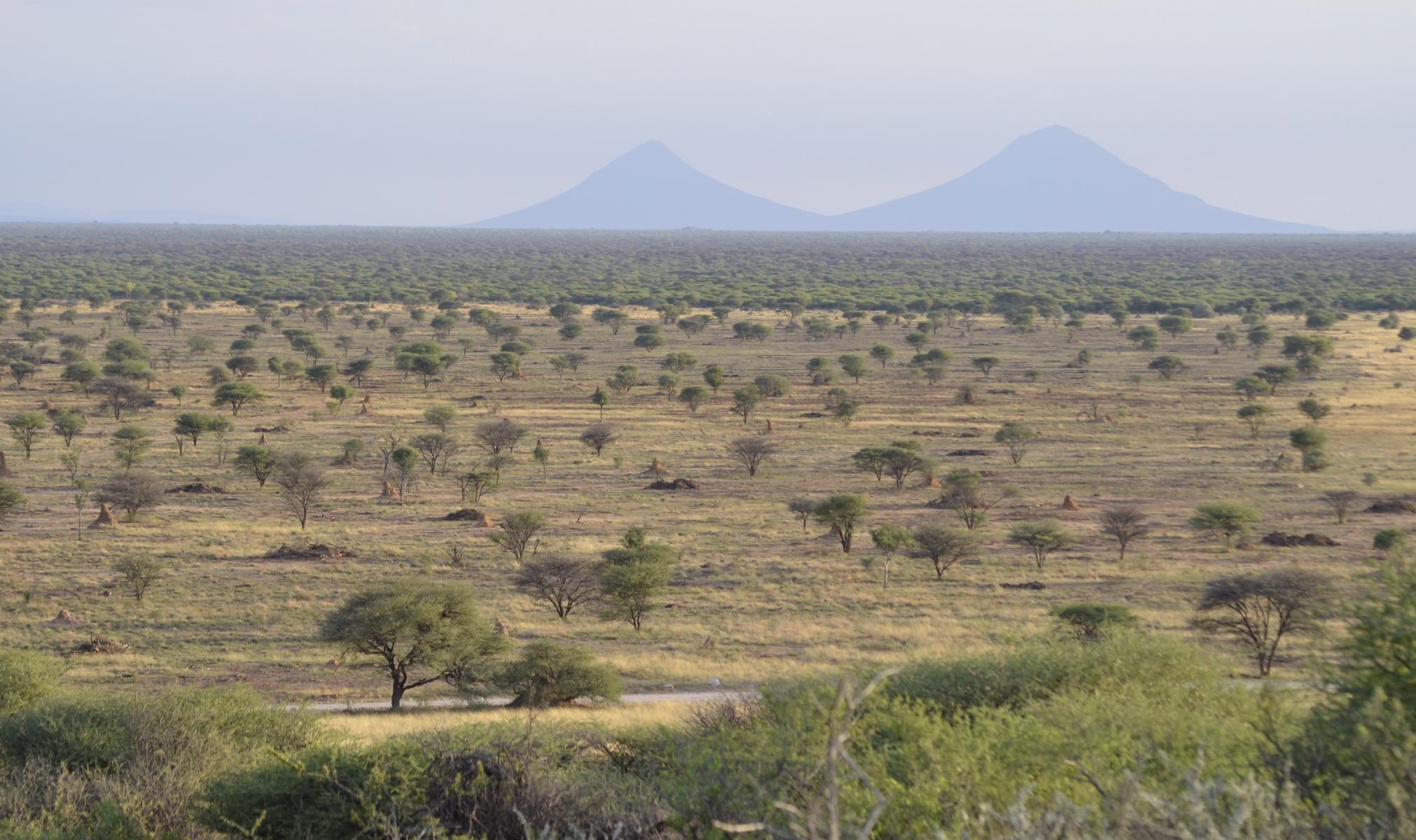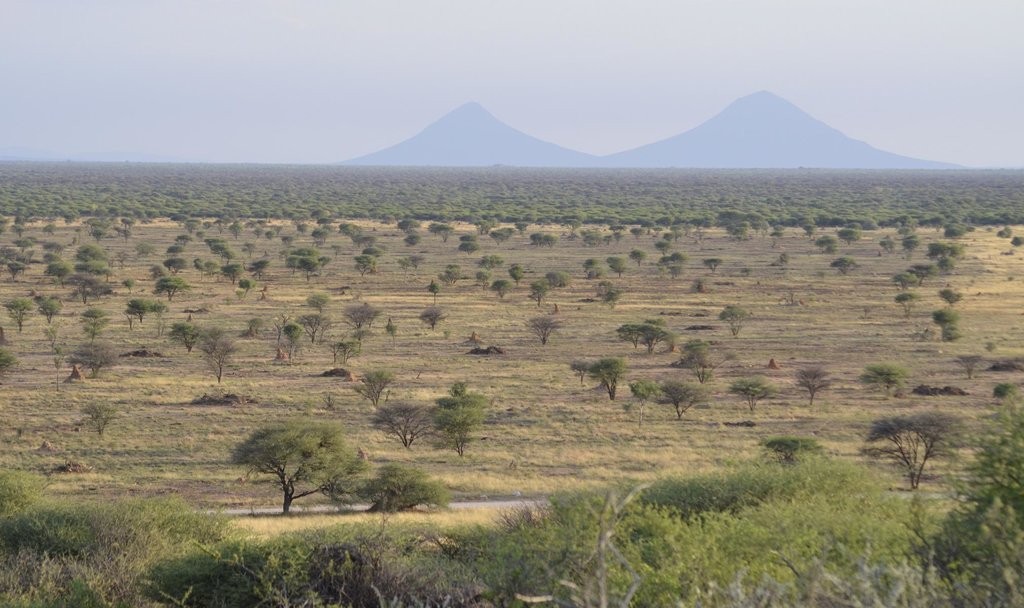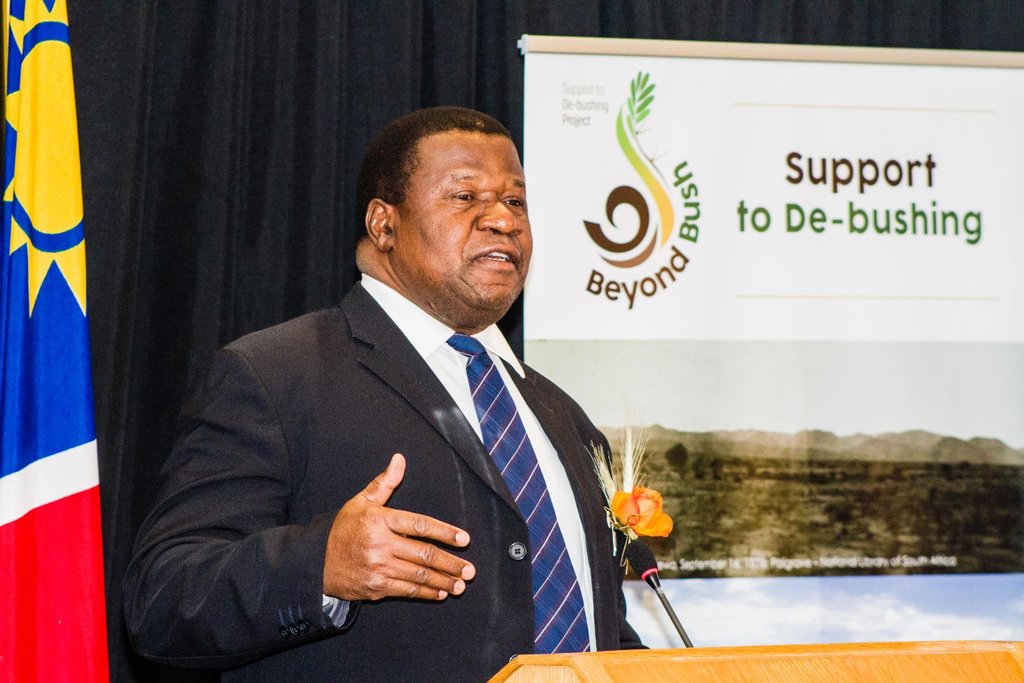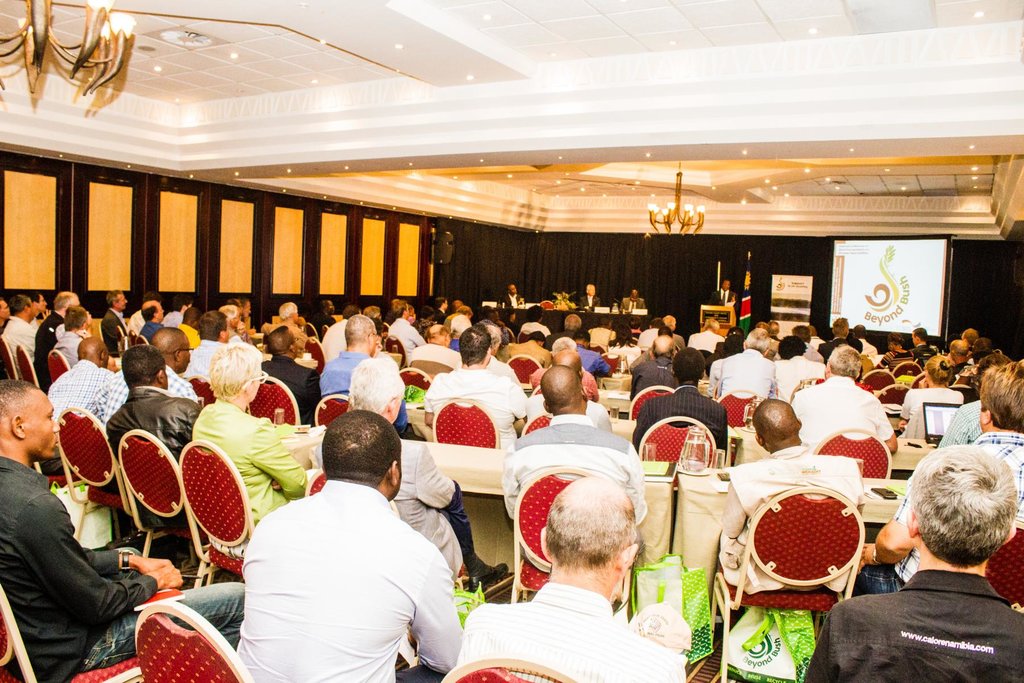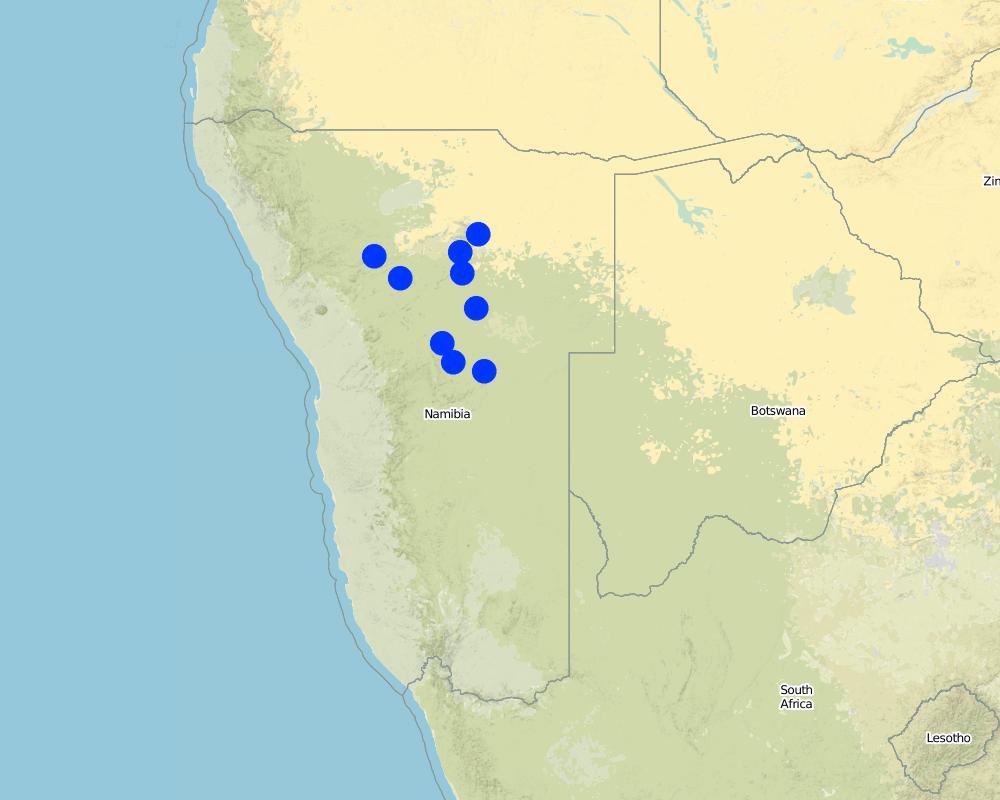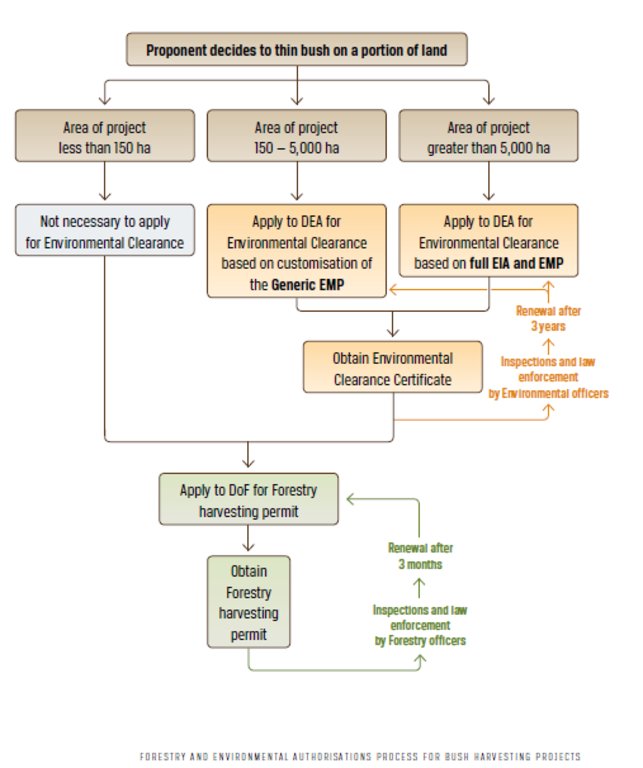Bush Control and Biomass Utilisation [Namibia]
- Creación:
- Actualización:
- Compilador: Johannes Laufs
- Editor: –
- Revisor: Rima Mekdaschi Studer
Bush Control and Biomass Utilisation
approaches_2809 - Namibia
Visualizar secciones
Expandir todo Colapsar todos1. Información general
1.2 Detalles de contacto de las personas de referencia e instituciones involucradas en la evaluación y la documentación del Enfoque
Nombre de la(s) institución(es) que facilitaron la documentación/ evaluación del Enfoque si fuera relevante)
Deutsche Gesellschaft für Internationale Zusammenarbeit (GIZ) GmbH (GIZ) - Alemania1.3 Condiciones referidas al uso de datos documentados mediante WOCAT
¿Cuándo se compilaron los datos (en el campo)?
01/06/2015
El compilador y la/s persona(s) de referencia claves aceptan las condiciones acerca del uso de los datos documentados mediante WOCAT :
Sí
1.4 Referencia/s al/los Cuestionario(s) de Tecnologías MST
2. Descripción del Enfoque MST
2.1 Breve descripción del Enfoque
Public and private stakeholders in Namibia cooperate in the implementation of a national Bush Control and Biomass Utilisation programme. The programme consists of the three components (1) Creation of an enabling framework, (2) Advisory Services and (3) Value Chain Development.
2.2 Descripción detallada del Enfoque MST
Descripción detallada del Enfoque MST:
Public and private stakeholders in Namibia cooperate in the implementation of a national Bush Control and Biomass Utilisation programme. It is a response to the immense challenge of bush encroachment in the country.
Namibia is affected by bush encroachment on a massive scale. The phenomenon currently affects some 45 million hectares of farmland in 9 of the country’s 14 regions. Bush encroachment has lowered the livestock capacity of rangeland by up to two thirds. It further results in severely reduced biodiversity and limits the recharge of groundwater.
Various factors contribute to the accelerating rate of bush encroachment in Namibia. A primary cause of bush encroachment of savannas is overgrazing by livestock. When overgrazed, the grass layer loses its competitive advantage and its ability to utilise nutrients and water efficiently. Higher infiltration of water and nutrients into the sub-soil results, which in turn benefits bush and tree species, allowing them to dominate.
Another important theory is the state-and-transition model, which states that savanna ecosystems are event-driven, where rainfall and its variability impact on vegetation growth and its composition. This model implies that bush encroachment is not a permanent phenomenon and that a savanna can be changed to its grass-dominated state by favourable management or environmental conditions. Woody plants establish themselves after dry periods followed by a few wet years, and then maintain themselves by utilising most of the water. Rather than a gradual annual increase in numbers, the general rule is that woody plants establish in large numbers during certain years and at varying intervals.
Other factors contributing to bush encroachment are the reduction in the frequency of wildfires as well as the absence of browsers (e.g. through fencing of farms and replacing the natural composition of wildlife by cattle or smallstock).
Bush encroachment is accompanied by a change in the dominant grasses: perennial grasses are often lost, being replaced by annual species often of inferior quality for livestock. Annual grasses are generally less productive than perennial grasses. Thus, animal production on an annual grass sward is very precarious and less sustainable.
Despite the negative impacts, the encroacher bush has developed into a huge biomass resource, estimated at about 200 to 300 million tonnes. Measures used to combat bush encroachment create positive opportunities for the Namibian economy, such as the use of the resource for electricity generation and value chain development in other sectors. Bush harvesting therefore offers the potential to increase agricultural productivity, economic growth, employment and energy security, without competing with food production.
In line with the national development plans, the approach aims to strengthen the restoration of productive rangeland in Namibia. It identifies value chain opportunities to trigger large-scale bush thinning activities. Its focus is closely aligned to the National Industrial Policy of 2012 and the Growth at Home Strategy, which promote domestic value addition for local resources. The project will foster institutional development in the biomass sector and provide support to improve the legal and regulatory framework for large-scale bush control.
The programme consists of the following three components:
(1) Creation of an enabling framework: harmonisation of sector policies and improvement of relevant regulations; strengthening of institutional capacities.
(2) Advisory Services: strengthening of existing farmer outreach services and knowledge dissemination to farmers, businesses and public sector decision makers.
(3) Value Chain Development: identification and piloting of relevant value chains for encroacher bush as a trigger for bush control.
The programme is implemented in collaboration of various public and private sector stakeholders. Its coordination is ensured through a cross-sector steering committee, which includes the line ministries of the following sectors: national planning, agriculture, environment, energy, industrialisation.
Key outputs of the programme include:
Enabling Environment:
- Strategic Environmental Assessment (SEA)
- Introduction of Harvesting Authorisations Guidelines
- Development of dedicated financial products (loan subsidy schemes).
Institutions:
- Introduction of the De-bushing Advisory Service (DAS)
- Introduction of the Namibia Biomass Industry Group (N-BiG).
Knowledge:
- Compilation of baseline data on bush encroachment and bush control
- Technical know how on technologies
- Compilation of relevant regulations and environmental principles.
Value Chain Development:
- Piloting of various value chains, including modernised charcoal production, bush based animal feed and household cooking fuel.
2.3 Fotos del Enfoque
2.5 País/ región/ lugares donde el Enfoque fue aplicado
País:
Namibia
Región/ Estado/ Provincia:
Bush control is applied across Namibia on many privately owned farms. Activities are most concentrated in the regions of Khomas, Omaheke, Otjozondjupa and Oshikoto.
Especifique más el lugar :
Pointers indicate hotspots (e.g. urban centres) around which activities are concentrated. It is not possible to depict each site where bush control is implemented due to the high number of individual activities and because no GIS based mapping has been conducted.
Map
×2.6 Fechas de inicio y conclusión del Enfoque
Indique año del inicio:
2014
Si no se conoce el año preciso, indique la fecha aproximada en la que se inició el Enfoque:
hace menos de 10 años (recientemente)
Año de conclusión (si el Enfoque ya no se aplica):
2021
2.7 Tipo de Enfoque
- proyecto/ basado en un programa
2.8 Propósitos/ objetivos principales del Enfoque
Develop, test and upscale the implementation of bush control technologies in Namibia.
2.9 Condiciones que facilitan o impiden la implementación de la/s Tecnología/s aplicadas bajo el Enfoque
normas y valores sociales/ culturales/ religiosos
- facilitan
Strong awareness of the need to implement bush control across all stakeholder groups.
- impiden
Low level of cooperation and information exchange.
disponibilidad/ acceso a recursos y servicios financieros
- impiden
Limited variety of dedicated/customised financial products available; cost of finance high.
entorno institucional
- impiden
Low level of cross-sector coordination and limited funding sources for sector representative bodies (e.g. associations).
colaboración/ coordinación de actores
- impiden
Low level of interaction and knowledge sharing.
marco de trabajo legal (tenencia de tierra, derechos de uso de tierra y agua)
- facilitan
Clear land tenure in commercial areas and suitable concepts in communal areas (e.g. conservancies and community forests).
políticas
- impiden
Low level of policy harmonisation across sectors; need to resolve conflicting mandates of relevant authorities (e.g. industrialisation vs. resource protection).
gobernanza de tierras (toma de decisiones, implementación y aplicación)
- facilitan
Clear governance and management in commercial areas
- impiden
Unclear decision making processes for income generating projects in communal areas.
conocimiento de MST, acceso a apoyo técnico
- impiden
Low level of bush control know how among land owners
mercados (para comprar insumos, vender productos) y precios
- facilitan
High national and international demand for woody products
carga de trabajo, disponibilidad de mano de obra
- impiden
Low level of skills among workers
3. Participación y roles de las partes interesadas involucradas
3.1 Partes interesadas involucradas en el Enfoque y sus roles
- usuarios locales de tierras/ comunidades locales
Commercial farmers, communal farmers
Implementation of bush control and/or availing land for bush control and biomass utilisation activities
- organizaciones comunitarias
conservancies, community forests
Implementation of bush control and/or availing land for bush control and biomass utilisation activities
- especialistas MST/consejeros agrícolas
Farmer outreach services and independent experts
Dissemination of information and skills development
- investigadores
Namibia University of Science (NUST), University of Namibia (UNAM)
Complementary research projects
- sector privado
Namibia Biomass Industry Group (N-BiG)
Representation of corporates involved in bush harvesting and biomass value addition.
- gobierno nacional (planificadores, autoridades)
National Planning Commission (NPC)
Ministry of Agriculture, Water and Forestry (MAWF)
Ministry of Environment and Tourism (MET)
Ministry of Mines and Energy (MME)
Ministry of Industrialisation and SME Development (MITSMED)
Policy and strategy development; sector steering; law enforcement, monitoring and evaluation.
- organización internacional
Deutsche Gesellschaft für Internationale Zusammmenarbeit (GIZ)
Implementation of bilateral cooperation project
3.2 Involucramiento de los usuarios locales de tierras/ comunidades locales en las distintas fases del Enfoque
| Involucramiento de los usuarios locales de tierras/ comunidades locales | Especifique quién se involucró y describa las actividades | |
|---|---|---|
| iniciación/ motivación | auto-movilización | High awareness and mobilisation within the farming community |
| planificación | interactivo | Good participation in public workshops and conferences |
| implementación | auto-movilización | Implementation of bush control by individual farmers |
| monitoreo y evaluación | pasivo | Very limited monitoring and evaluation through individual land owners |
3.3 Flujograma (si estuviera disponible)
Descripción:
Legal and regulatory framework for large scale bush control: the flow chart explains the three levels of categories for the Environmental Clearance process. The categories are as follows:
- Small bush harvesting operations covering less than 150 ha: no environmental clearance required
- Medium bush harvesting operations covering between 150 and 5 000 ha: environmental clearance based on a generic Environmental Management Plan (EMP) is needed
- Large bush harvesting operations of more than 5 000 ha, Environmental Clearance based on Environmental Impact Assessment (EIA) and Environmental Management Plan (EMP)
Abbreviations:
DEA - Directorate of Environmental Affairs, Ministry of Environment and Tourism
DoF - Directorate of Forestry, Ministry of Agriculture, Water and Forestry
EIA - Environmental Impact Assessment
EMP - Environmental Management Plan
ha - hectares
Autor:
Southern African Institute for Environmental Assessment (2016)
3.4 La toma de decisiones en la selección de Tecnología(s) MST
Especifique quién decidió la selección de las Tecnología/ Tecnologías a implementarse:
- todos los actores relevantes, como parte de un enfoque participativo
Especifique las bases que sustentaron la toma de decisiones:
- la evaluación de conocimiento MST bien documentado (la toma de decisiones se basa en evidencia)
- hallazgos de investigaciones
- la experiencia personal y opiniones (no documentadas)
4. Apoyo técnico, fortalecimiento institucional y gestión del conocimiento
4.1 Construcción de capacidades / capacitación
¿Se proporcionó la capacitación a usuarios de tierras/ otras partes interesadas?
Sí
Especifique quién fue capacitado:
- personal de campo/ consejeros
Forma de capacitación:
- en el contexto de trabajo
- áreas de demostración
- reuniones públicas
Temas avanzados:
- Environmental and forestry policy and policy emplementation (training for government officials from regional offices)
- Implementation of bush control and biomass processing (training for farmers and SMEs)
4.2 Servicio de asesoría
¿Los usuarios de tierras tienen acceso a un servicio de asesoría?
Sí
Especifique si servicio proporcionado se realizó:
- en centros permanentes
Describa/ comentarios:
Advisory services through the De-bushing Advisory Service (DAS, www.dasnamibia.org)
4.3 Fortalecimiento institucional (desarrollo institucional)
¿Se establecieron o fortalecieron instituciones mediante el Enfoque?
- sí, mucho
Especifique el nivel o los niveles en los que se fortalecieron o establecieron las instituciones:
- nacional
Describa la institución, roles y responsabilidades, miembros, etc.
Launch of
- De-bushing Advisory Service (DAS)
- Namibia Biomass Industry Group (N-BiG)
Re-organisation of
- Namibia Charcoal Association (NCA)
Especifique el tipo de apoyo:
- financiero
- construcción de capacidades/ entrenamiento
- equipo
- Institutional Development
Proporcione detalles adicionales:
Three sector institutions have been supported in order to achieve increased coordination of efforts. The Namibia Biomass Industry Group (N-BiG) is a non-profit association, representing the interest of bush harvesting and processing companies. The De-bushing Advisory Service (DAS) is a national platform for the dissemination of knowledge on the topics of bush encroachment, bush control and biomass utilisation.
The Namibia Charcoal Association (NCA) represents the already well established charcoal production sector. Through a re-organisation process, the association has been strengthended and turned into a fully functioning sector representation.
Thre three organisations are planned to merge in the near future in order to achieve a better alignment of their mandates and synergies of activities.
4.4 Monitoreo y evaluación
¿El monitoreo y la evaluación forman parte del Enfoque?
Sí
Comentarios:
National Bush Information System
- Scope of bush encroachment
- Scope of bush control activities
- Success rate of bush control methodologies, incl. secondary impacts (employment)
Si respondió que sí, ¿la documentación se utilizará para monitoreo y evaluación?
No
4.5 Investigación
¿La investigación formó parte del Enfoque?
Sí
Especifique los temas:
- economía/ marketing
- ecología
- tecnología
Proporcione detalles adicionales e indique quién hizo la investigación:
Collaboration with scientific institutions and networks on:
- Identification and development of suitable technology
- Correlation with ecosystem services, e.g. grounwater recharge and biodiversity
- Identification of market for bush based products
5. Financiamiento y apoyo material externo
5.1 Presupuesto anual para el componente MST del Enfoque
Si no se conoce el presupuesto anual preciso, indique el rango:
- > 1,000,000
Comentarios (ej. fuentes principales de financiamiento/ donantes principales):
Pooling of resources between national government, international donors and private sector
5.2 Apoyo financiero/material proporcionado a los usuarios de tierras
¿Los usuarios de tierras recibieron financiamiento/ apoyo material para implementar la Tecnología/ Tecnologías? :
No
5.3 Subsidios para insumos específicos (incluyendo mano de obra)
- ninguno
Si la mano de obra de usuarios de tierras fue un insumo sustancial, ¿fue:
- voluntario?
5.4 Crédito
¿Se proporcionó crédito bajo el Enfoque para actividades MST?
Sí
Especifique las condiciones (tasa de interés el apoyo, amortización, etc.):
Commercial loans with grace period of up to 3 years and interest rate of 7-8%
Especifique los proveedores de crédito:
Commercial banks: First National Bank (FNB), Agribank
Development Bank of Namibia (DBN)
Environmental Investment Fund (EIF)
Especifique los destinatarios del crédito :
- Individual households/farmers
- Service providers/business
5.5 Otros incentivos o instrumentos
¿Se usaron otros incentivos o instrumentos para promover la implementación de Tecnologías MST?
Sí
Si fuera el caso, especifique :
Development of authorisations guidelines and review of regulations with regard to Environmental Management Plans (EMPs) and Environmental Impact Assessments (EIAs).
6. Análisis de impacto y comentarios de conclusión
6.1 Impactos del Enfoque
¿El Enfoque empoderó a los usuarios locales de tierras, mejoró el involucramiento de las partes interesadas?
- No
- Sí, un poco
- Sí, moderadamente
- Sí, mucho
Increased dissemination of information and exchange between land users on experiences with technologies; stakeholder representation through associations and participation in high level national conferences.
¿El Enfoque facilitó la toma de decisiones basada en evidencia?
- No
- Sí, un poco
- Sí, moderadamente
- Sí, mucho
Various publications to capture best practices in bush control and biomass utilisation, including farmers manuals.
¿El Enfoque ayudó a los usuarios de tierras a implementar y mantener Tecnologías MST?
- No
- Sí, un poco
- Sí, moderadamente
- Sí, mucho
Development of various guidelines
¿El Enfoque mejoró la coordinación e implementación efectiva en costos de MST?
- No
- Sí, un poco
- Sí, moderadamente
- Sí, mucho
Improvement of cross-sector collaboration through steering committee
¿El Enfoque movilizó/mejoró el acceso a recursos financieros para implementar MST?
- No
- Sí, un poco
- Sí, moderadamente
- Sí, mucho
Involvement of financial institutions with the aim to develop customised financial products.
¿El Enfoque mejoró el conocimiento y capacidades de los usuarios para implementar MST?
- No
- Sí, un poco
- Sí, moderadamente
- Sí, mucho
Various publications to capture best practices in bush control and biomass utilisation, including farmers manuals.
¿El Enfoque mejoró el conocimiento y capacidades de otras partes interesadas?
- No
- Sí, un poco
- Sí, moderadamente
- Sí, mucho
Increase awareness of the opportunity of the biomass resource among public sector stakeholders as well as within the business community.
¿El Enfoque construyó/ fortaleció instituciones, colaboración entre partes interesadas?
- No
- Sí, un poco
- Sí, moderadamente
- Sí, mucho
Through introduction of steering committee, working groups as well as through the strengthening of sector representative bodies/associations.
¿El Enfoque empoderó a grupos en desventaja social y económica?
- No
- Sí, un poco
- Sí, moderadamente
- Sí, mucho
Employment creation in bush control and biomass utilisation, e.g. in charcoal production
¿El Enfoque mejoró la equidad de género y empoderó a las mujeres y niñas?
- No
- Sí, un poco
- Sí, moderadamente
- Sí, mucho
Promotion of dedicated employment opportunities for women, e.g. in charcoal packaging
¿El Enfoque llevó a un acceso mejorado a tierra y saneamiento?
- No
- Sí, un poco
- Sí, moderadamente
- Sí, mucho
Improved groundwater recharge in bush controlled areas. Research is ongoing and first results indicate a significantly improved infiltration of rainwater into the groundwater. The reduced number of bushes leads to reduced evapotranspiration.
¿El Enfoque llevó a un uso más sostenible/ fuentes de energía?
- No
- Sí, un poco
- Sí, moderadamente
- Sí, mucho
First biomass energy projects launched (industrial heating) and in preparation (national grid electricity production).
¿El Enfoque llevó a oportunidades de empleo, ingresos?
- No
- Sí, un poco
- Sí, moderadamente
- Sí, mucho
Employment in bush harvesting and processing, especially in charcoal production.
6.2 Motivación principal del usuario de la tierra para implementar MST
- producción incrementada
Need for bush control in order to increase carrying capacity of land.
- reducción de la degradación de la tierra
Rehabilitation of land through bush thinning.
6.3 Sostenibilidad de las actividades del Enfoque
¿Pueden los usuarios de tierras sostener lo que se implementó mediante el Enfoque (sin apoyo externo)?
- sí
Si respondió que sí, describa cómo:
Land users have the capacity to implement bush control, either with own means (mainly manual and semi-mechanised bush harvesting) or through the involvement of service providers (mainly fully mechanised bush harvesting for the supply of large-scale off-takers).
6.4 Fortalezas/ ventajas del Enfoque
| Fuerzas/ ventajas/ oportunidades desde la perspectiva del usuario de la tierra |
|---|
| Financial viability of bush control through the introduction of value chains (as compared to mere removal of the biomass) |
| Improved access to information and know how |
| Improved advocacy/ communication with government authorities |
| Fuerzas/ ventajas/ oportunidades desde la perspectiva del compilador o de otra persona de referencia clave |
|---|
| Mindshift among public and decision makers from focus on the challenge (bush encroachment) to the opportunities (value addition). |
| Cross-sector cooperation through steering committee |
| Involvement of private sector as driving force for implementation |
6.5 Debilidades/ desventajas del Enfoque y formas de sobreponerse a ellos
| Debilidades/ desventajas/ riesgos desde la perspectiva del usuario de la tierra | ¿Cómo sobreponerse a ellas? |
|---|---|
| Limited direct (financial) support | Introdution of incentive schemes |
| Limited opportunities in remote areas, i.e. when distance to biomass off-takers is too large | Further development of on-farm solutions (e.g. bush-to-feed) |
| Debilidades/ desventajas/ riesgos desde la perspectiva del compilador o de otra persona de referencia clave | ¿Cómo sobreponerse a ellas? |
|---|---|
| Complex programme steering requirements, due to multi-sector relevance. The national programme for Bush control and Biomass Utilisation is currently anchored in the Directorate of Forestry (DoF) of the Ministry of Agriculture. This adequately accounts for the fact that the bush resource is part of the national forestry/biomass resource and its utilisation must be regulated as such. However, this anchoring does not allow for an effective promotion of biomass utilisation (e.g. SME promotion, industrialisation concepts, development of logistics hubs) and innovative end-uses (e.g. development of biomass power plants). For this purpose other line ministries, such as Ministry of Mines and Energy (MME) as well as Ministry of Industrialisation and SME Development (MITSMED) are part of the programme's steering committee. | Establishment of national coordinating body to formalise the current steering committee |
7. Referencias y vínculos
7.1 Métodos/ fuentes de información
- entrevistas con usuarios de tierras
- entrevistas con especialistas/ expertos en MST
7.2 Referencias a publicaciones disponibles
Título, autor, año, ISBN:
Baseline Assessment for De-bushing Programme in Namibia (2014)
¿Dónde se halla disponible? ¿Costo?
GIZ Support to De-bushing Project, www.dasnamibia.org/downloads
7.3 Vínculos a la información relevante disponible en línea
Título/ descripción:
De-bushing Advisory Service (DAS) Namibia, Resource Section
URL:
www.dasnamibia.org/downloads
Título/ descripción:
Namibia Biomass Industry Group (N-BiG)
URL:
www.n-big.org
Vínculos y módulos
Expandir todo Colapsar todosVínculos
No hay vínculos
Módulos
No se hallaron módulos


